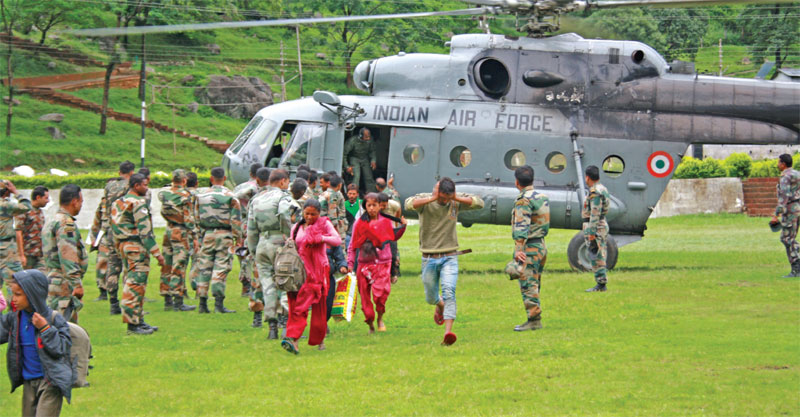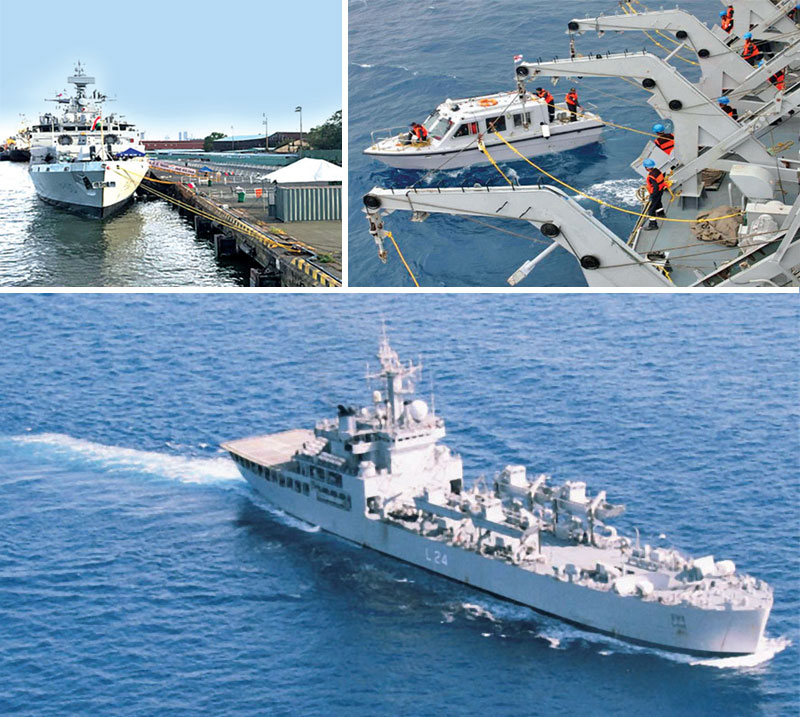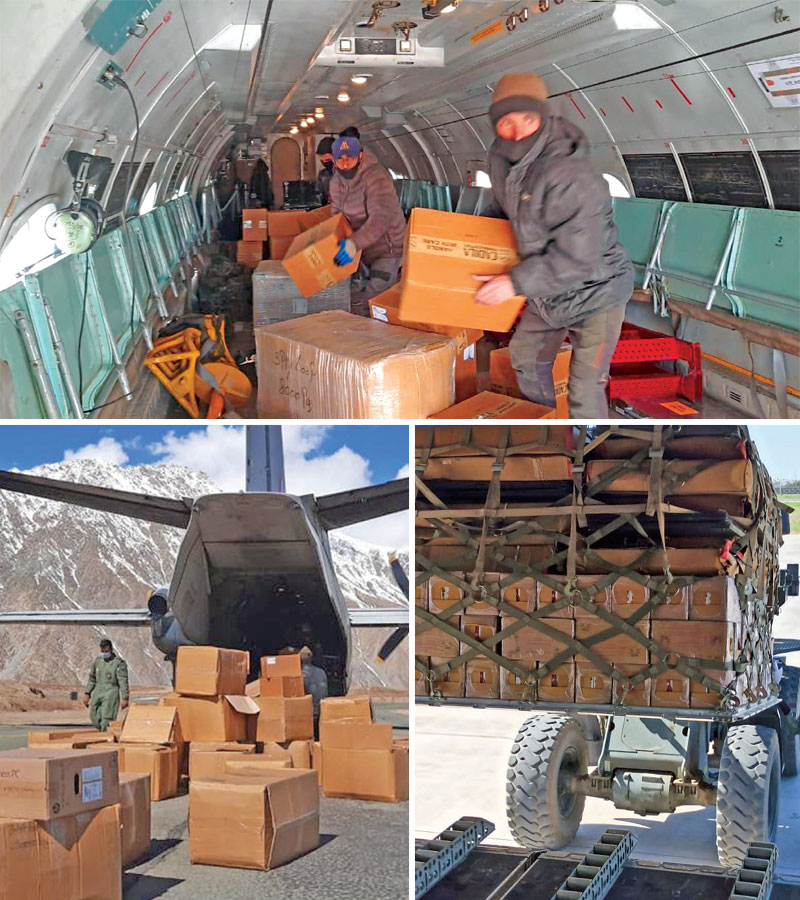Given the soft power value of humanitarian assistance, government needs to institutionalise the mechanism
 Cdr Ranjan Bhattacharya (retd)
Cdr Ranjan Bhattacharya (retd)
The year was 2004. On December 26, at about 8am local time an earthquake measuring 9.1-9.3 on the Richter’s scale caused by a rupture along the fault line between the Burma and the Indian plate. Epi-centered off the west coast of northern Sumatra, Indonesia, the earthquake was followed by a massive series of Tsunami waves triggered by it, racing across the Indian Ocean reaching heights of more than 30 feet in some places, which devastated coastal areas as far away as East coast of Africa.
Amidst this unfortunate mega event that left the region shellshocked, the response of the Indian government, one of the victims of the tsunami, was proactive and in consonance with our age-old ethos of ‘vasudaiva kutumbakam’–which in Sanskrit means, ‘the world is one family’. India extended her arms in support almost instantly.
I remember the day clearly. As a young naval officer posted at Mumbai, I found myself at the epicenter of the relief operations that were quickly set in motion with ships of the Western Naval Command being readied with almost wartime urgency. Even as boilers were flashed, personnel recalled, fuel and provisions embarked, relief material started pouring in destined for the worst hit areas in our neighbourhood. As the rest of the world deliberated, one of the victims of this catastrophe was the ‘first responder’ with critical relief for their fellow victims.
As our nation healed from this calamity slowly, we did not leave others behind. What can be more rewarding than this knowledge that India doesn’t shut its doors when faced with challenges, we open our hearts to reach out to everyone else in need. As I look back upon those days, I don’t think I have felt a greater surge of pride in my national identity, or a greater sense of purpose throughout my uniformed service. More than a decade and half later, as the entire world is reeling under the pandemic that doesn’t discriminate between the first or third world nations, afflicting the rich and poor in equal measure, one nation started shipping out vaccines destined for those who have none.

Humanitarian Assistance and Disaster Relief
The Organisation for Economic Cooperation and Development (OECD) defines humanitarian assistance as ‘actions designed to save lives, alleviate suffering and maintain and protect human dignity during and in the aftermath of emergencies.’ According to the United Nations Office for the Coordination of Humanitarian Assistance (UNOCHA), humanitarian assistance would include ‘protection of civilians including those who are no longer taking part in hostilities, and the provision of food, water and sanitation, shelter, health services and other items of assistance, undertaken for the benefit of affected people and to facilitate return to normal lives and livelihood.’ Thus, humanitarian assistance is clearly different from long-term development aid because it is undertaken in the aftermath of disasters and aimed to provide immediate relief.
Indian Policy for HADR
While the government of India doesn’t use a standard definition for HADR, it considers humanitarian assistance and disaster relief to be ‘activities that assuage human suffering caused by natural disasters like cyclones, droughts, earthquakes or floods.’ While our policy for assistance does not include aid to civilian population in conflict or post conflict zones specifically, we have rendered aid in post conflict Sri Lanka and Afghanistan which is in consonance with our national policies of non-alignment, and safeguarding our national interests through ensuring regional stability and harmony.
India has thus far favoured direct government-to-government aid and shied away from using services of donor/ aid agencies for the purpose, so as to leave room for diplomatic exchanges with the recipient nation at a later date. However, a clear governmental policy towards HADR still awaits formulation and implementation.
India’s Present HADR Organisation
The task of managing India’s response to HADR lies with the Development Partnership Administration (DPA) division of MEA, which co-ordinates with other governmental agencies within the central government as well as other state bodies and civil society.
Since 2011-12, the union budget has a separate line item on ‘Aid for Disaster Relief’ under its Grants and Loans to foreign government subhead. Out of the INR 7,150 crore provision for foreign aid in our current union budget, the provision for disaster relief is only INR 20 crore which is less than 0.28 per cent of the total allocation for foreign aid (total budgetary expenditure INR 3,483,236 crore). It is pertinent to mention that the sum total of India’s outflow in the past two decades for HADR would be less than INR 550 crore.
While the NDMA was set up in 2005 to coordinate the domestic relief management during natural calamities and disaster, there is no central body or organisation that has complete ownership for coordinating International HADR relief operations. Hence all our relief operations are overseen by only a broad-based group that leaves initiative to individual organisations to scrape together whatever response they deem fit. The necessity for a dedicated body that takes ownership, maintains and deploys resources and is accountable for planning, providing resources, monitoring and analysing the country’s HADR response clearly exists. The Indian Army, Navy, Airforce and Coast Guard resources are pressed into service as available whenever the need arises, but a coherent policy is conspicuous by its absence. Thus, their efforts are purely reactive because the armed forces are not as customised as desirable for HADR, which isn’t their primary role.
India’s HADR Footprint
In the past 20 years, India has been involved in several HADR missions in her immediate neighbourhood. In addition, India has proactively used her military and diplomatic resources in evacuation of Indian and foreign nationals from strife torn areas. Despite the fact that India herself has been at the receiving end of natural disasters at regular intervals, it did not deter her from extending all possible assistance to her neighbours.
However, India’s contribution towards such operations is significantly lower when compared to her economic, military, scientific and industrial growth in the last three decades. India’s HADR contributions have followed the following broad routes:
(a) Direct Bilateral HADR initiatives;
(b) Initiatives of several state governments who have also been active in rendering assistance to neighbouring countries because of cultural, religious and ethnic ties;
(c) Initiatives by several Indian NGOs and religious organisations who have also been active in mobilising and distribution of relief material in our immediate neighbourhood; and
(d) Initiatives in partnership with global aid and relief agencies.
Need For HADR
The last few decades have seen India’s growth as a responsible power with a vibrant economy and a youthful population. India prides itself on being a regional power of some repute. From being a recipient of aid at one time, India now not only refuses aid but is capable of rendering aid to the region as necessary.
The ability to effectively render assistance to nations in the IOR serves to enhance our ‘soft power’ considerably and needs to be a part of our stated policy. For that to happen, we need to not only budget for such expenses but also put together a guiding policy. Such a policy should mandate humanitarian relief not only for natural disasters, but also must provide developmental initiatives to enhance the quality of life even when facing man-made emergencies.

Assistance in Complex Humanitarian Emergency
While the necessity to respond during a disaster is clear, intervention to address humanitarian crisis as a fallout of internal strife has severe diplomatic ramifications. The 1994 Oslo Guidelines mandates that ‘While Humanitarian Assistance must be provided with the core principles of Humanity, Impartiality and Neutrality, they must fully respect sovereign rights of nations. And herein we come to an ethical dilemma that needs resolution; honouring the sovereign rights of nations, as against preservation of human life under Responsibility to Protect (R2P) those who cannot protect themselves. As has been demonstrated during the Balkan crisis, the Rwandan genocide and recently in Sri Lanka, Myanmar and Syria, needless loss of the weak have occurred when the world refused to act.’
The R2P was endorsed by member states in 2005 but the Veto power vested with the UNSC often ensures inaction. India has maintained her stance of Neutrality and Non-alignment steadfastly, but we did intervene in Sri Lanka and Afghanistan. There is a need to re-evaluate our stance. For too long have we avoided the obvious, but a nation that sees herself as an emerging power, must stand with the defenceless, and avoid inaction because preservation of human life must be our paramount responsibility.
Desired Organisation for HADR
India’s efforts in the realm of foreign assistance have thus far been a story of too little, too limited geographically and too directionless. It is high time that the diplomatic and commercial aspects of developmental aid/ relief be recognised by the government, and used for symbiotic benefit of the donor-recipient ecosystem. If I have to stick my neck out and generate a wish list, it will include but not be limited to the following:
Policy: Formulate a clear, all-encompassing policy for India’s international HADR response. It is imperative to recognise that HADR initiatives and foreign aid are important tools in enhancing the soft power of the state and needs to be exploited in a responsible and non-threatening manner. While we must continue to respond to disaster situations, we need to re-evaluate our position of neutrality when facing a humanitarian emergency from man-made situations.
Structure: Set up an organisation responsible for planning, analysing and forecasting India’s non disaster related aid programme as well as for HADR. While such an organisation could function under the ambit of the MEA, it must be populated by specialists from multiple disciplines with prior experience in such operations. The need of the hour is at least a separate division under the MEA, if not a whole ministry, with its own budget and clear mandate, under the charge of a minister of state to ensure necessary authority to mobilise resources.
Delivery Mechanism for Aid: In the interim, till such time a dedicated organisation to handle international aid and relief operations is in place, the Indian Red Cross Society (IRCS), which was established by an act of the Parliament, could be bolstered and given a greater role in coordinating the collection and deployment of aid.
Capability Building: In the present world order, the armed forces will increasingly be called upon to assume non-combat roles, of which, HADR will remain one of the most important capabilities. Indian Army, Indian Navy and the Air Forces routinely train and prepare for ‘Out of Area Contingencies (OOAC) and Operations Other than War (OOTW)’. Future capability development/ force levels should factor in the need to utilise the resources for such operations.
Cooperative Engagements: India must take a lead for putting in place regional HADR initiatives through SAARC, BIMSTEC, IORA and ASEAN. Such multinational efforts will assuage the concerns of recipients in case India’s solitary efforts be viewed with suspicion.
Greater interaction and cooperation with international bodies such as World Food Programme, UN bodies and other agencies needs to be undertaken to provide humanitarian aid where necessary.

Crystal Ball Gazing
In the days ahead, non-traditional emergencies will occupy centre stage as newer threats to disrupt of the established world order emerge. We need to increase the ambit of aid and relief to include man-made humanitarian disaster such as conflicts, terrorist attacks, internal strife and genocide, ecological emergencies, industrial accidents, pandemics, and non-state sponsored cyber-attacks, and search and rescue assistance from air/ maritime accidents. But in addition to such emergencies, a rising responsible power needs to assume a greater role in reaching out to every corner of the globe where humanity faces a crisis. These must include all efforts to build capacity in geographies where necessary and feasible, so as to facilitate achieving the Global Sustainable Development goals of the UN.
Conclusion
Over the past few decades, India’s economic rise coupled with her capability growth in science and technology, IT, and life sciences, has enhanced her stature on the world stage. In this period, India has transitioned from being an aid recipient nation to a donor state that takes pride at being the ‘first responder’ in her region, and with considerable success. Failure to leverage the goodwill that accrues from such operations will be a loss in economic, diplomatic and political terms.
The ‘soft power’ that accrues from such activities strengthen our claims for a permanent seat at the UNSC. The nation’s top leadership needs to be sensitised towards need for a comprehensive national policy for humanitarian assistance during natural as well as man-made disasters. An unambiguous policy stipulating responsibility for various agencies, appropriate resource allocation and capability building will help achieve such objectives. We need a robust organisation that is pro-active, efficient, and sufficiently agile to ensure expeditious positioning of resources where necessary.
Further, the need for co-operative engagement with regional and extra regional agencies to deliver assistance could be explored additionally. We have to work towards ensuring that appropriate aid reaches the intended target population as necessary, and in time to make a substantial difference.
(The writer is a former submariner from the Indian Navy)

